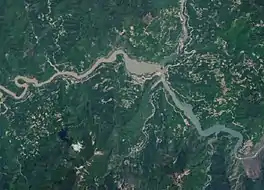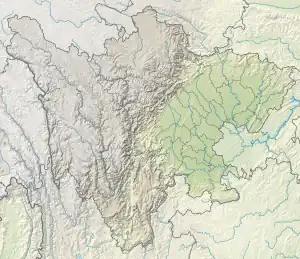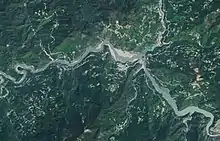| Tangjiashan Lake | |
|---|---|
 Tangjiashan Lake on 2016 Landsat imagery | |
 Tangjiashan Lake | |
.png.webp) Map of the lake as of June 3, 2008. | |
| Location | Beichuan, Sichuan |
| Coordinates | 31°50′12″N 104°27′18″E / 31.8366°N 104.4551°E |
| Type | Barrier lake |
| Primary inflows | Jian River |
| Basin countries | China |
| Surface area | 3.78 km2 (1.46 sq mi) |
| Water volume | 80×106 m3 (2.8×109 cu ft) |
Tangjiashan Lake (Chinese: 唐家山堰塞湖, literally "Tang's Mountain landslide dam-created lake") is a landslide dam-created lake on the Jian River, which was formed by the 2008 Sichuan earthquake.[1] Its name comes from the nearby mountain Tangjiashan. On May 24, 2008, the water level rose by 2 metres (6 ft 7 in) in a single day, reaching a depth of 23 metres (75 ft), just 29 metres (95 ft) below the barrier level.[1][2] On June 9, 2008, more than 250,000 people had been evacuated from Mianyang in anticipation of the Tangjiashan Lake dam bursting.[3][4]
A similar lake in the same province formed 222 years earlier caused one of the worst landslide-related disasters in history. On June 10, 1786, a landslide dam on Sichuan's Dadu River, created by an earthquake ten days earlier, burst and caused a flood that extended 1400 km downstream and killed 100,000 people.[5]
A "relatively strong" aftershock on June 8, 2008, shook the massive earthquake-formed lake that has been threatening to flood more than 1 million people and triggered landslides in surrounding mountains. Soldiers used digging equipment, explosives, and even missiles to blast channels in the dam in an attempt to relieve the pressure behind it.[6]
History
The flow from the sluice channel cut into the dam increased dramatically on June 10, 2008, going from 300 cubic metres/second to 7000 cubic metres/second in the span of four hours.[7] The muddy waters flowed rapidly downstream causing flooding in the evacuated town of Beichuan and overtopping of dams.[8]
Starting in June 2009, the lake was stabilized by strengthening the banks to prevent new landslides. In 2012, a discharge channel was finished, allowing the water level in the lake to be controlled.[9]
In 2013 broken banks from a severe flood caused the lake's water to fall to 503 metres above sea level, 40 metres below its peak and 9 metres below its 2010 level. As water receded, the Xuanping town in the Beichuan Qiang Autonomous County was revealed.

The lake is now within the Beichuan Earthquake Museum.[10] Landsat imagery from 2018 showed that the lake's size was greatly reduced due to natural erosion of the barrier and filling of the lake with sediment.[11]
As of 2018, there were plans to convert the lake to a controlled hydropower reservoir.[9]
See also
References
- 1 2 "Backgrounder: Tangjiashan lake". CCTV International. Retrieved 2008-05-28.
- ↑ Watts, Jonathan (2008-05-30). "200,000 flee from growing Sichuan lake". London: Guardian Unlimited. Retrieved 2008-05-30.
- ↑ "More people being evacuated from swollen lake area in southwest China". Xinhua News Agency. 2008-05-27. Archived from the original on May 28, 2008. Retrieved 2008-05-27.
- ↑ "Chinese quake lake still rising". BBC News. 2008-06-09.
- ↑ Schuster, R.L.; Wieczorek, G.F. (2002). "Landslide triggers and types". Landslides: Proceedings of the First European Conference on Landslides. A.A. Balkema Publishers: 59–78. ISBN 978-90-5809-393-6.
- ↑ "Mapping the earthquake zone". BBC News. 2008-06-10. Retrieved 2008-06-09.
- ↑ Petley, Dave (2008-06-10). "Dave's Landslide Blog".
- ↑ Wong, Edward (2008-06-10). "Flooding spreads more destruction in town below 'quake lake'". International Herald Tribune.
- 1 2 "防洪、供水、发电、旅游 绵阳唐家山堰塞湖综合开发拉开帷幄_四川在线". sichuan.scol.com.cn. Retrieved 2021-04-19.
- ↑ "北川国家地震遗址博物馆" (in Chinese). Phoenix News. March 31, 2009.
- ↑ "Demise of a Quake Lake". earthobservatory.nasa.gov. 7 September 2018.